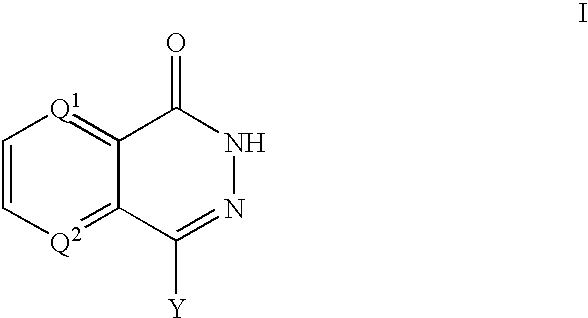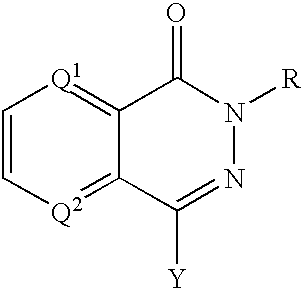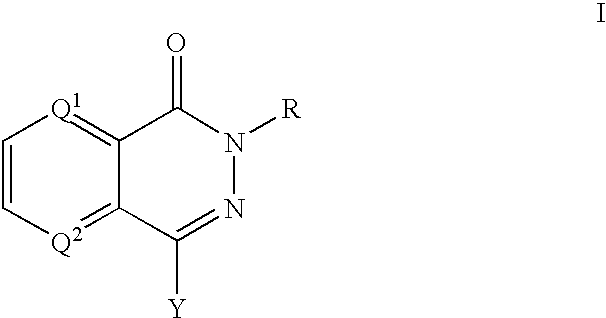PARP inhibitors
a technology of parp inhibitors and hphthalazine, which is applied in the direction of biocide, drug composition, cardiovascular disorder, etc., can solve the problems of cell death, parp activity activation, and depletion of cellular energy stores
- Summary
- Abstract
- Description
- Claims
- Application Information
AI Technical Summary
Benefits of technology
Problems solved by technology
Method used
Image
Examples
example 1
[0346]This example illustrate a method of producing a 4-diamine substituted 2H-phthalazin-1-one.
4-(3-amino-propylamino)-2H-phthalazin-1-one (R═H)
[0347]A 2-L, three-neck, round bottomed flask equipped with a mechanical stirrer and a thermometer was charged with 1,3-propanediamine (66.0 g, 0.890 mol) and ethanol (450 mL). Phthalic and anhydride (120 g, 0.811 mol) was then added portion-wise over 20 min. An exothermic reaction occurred, and a thick white precipitate formed. Stirring was continued for another 1 h, and the resulting precipitate was vacuum filtered. The cake was washed with ethanol (2×100 mL) affording 178 g of a white solid which was used directly. A 1-L, three-neck round bottomed flask equipped with a mechanical stirrer and a thermoregulator was charged with the above solid (50.0 g) and ethylene glycol (200 mL), and the reaction mixture was refluxed at 170° C. for 1 h. The volatiles were then distilled off until the temperature inside the flask reached 210° C. The heat...
example 2
[0351]This example illustrates a method for producing a diamine substituted 2H-phthalazin-1-one using a cyanobenzoate compound.
Procedure of I and III:
[0352]A mixture of 2-cyano-benzoic acid methyl ester (2 g, 12.4 mmol) and butane-1,4-diamine (1.09 g, 12.4 mmol) was heated at 80° C. in DMF (10 mL) overnight. Dichloromethane (i.e., DCM) was added and the organic layer was washed with saturated NaHCO3, 10% citric acid and brine, dried over MgSO4, filtered and concentrated. Purification using silica gel column chromatography (gradient of CH2Cl2 to CH2Cl2 / MeOH, 98 / 2) afforded 600 mg of cyclized material (24% yield). This material was treated with hydrazine hydrate as described in Example 1 to provide 4-(4-Amino-butylamino)-2H-phthalazin-1-one.
Procedure for IV and VII (1,3-cyclohexanediamine and 1,3-diamino-2-propanol):
[0353]To a solution of methyl 2-cyanobenzoate (322 mg, 2.00 mmol) in DMF (1 mL), 1,3-cyclohexanediamine (285 mg, 2.50 mmol) was added. The reaction mixture was heated at ...
example 3
Procedure for IX, X, XI
[0355]This example illustrates a method for producing a diamine substituted 2H-phthalazin-1-one using a mono-protected diamine compound.
[0356]Combined 2-cyano-benzoic acid methyl ester (0.40 g, 2.48 mmol) and 2.48 mmol of amine ((3-aminomethyl-phenyl)-carbamic acid tert-butyl ester or (3-amino-propyl)-methyl-carbamic acid tert-butyl ester or 4-Aminomethyl-piperidine-1-carboxylic acid tert-butyl ester) in 5 mL MeOH at 0° C. Added 2.73 mmol NaOMe (as 0.5M solution ) and stirred 3-18 h at RT. Removed solvent in vacuo and extracted with EtOAc (100 mL) and 0.5M NaHSO4 (2×15 mL) then brine (1×15 mL). Organic layer was dried (MgSO4) and concentrated in vacuo.
[0357]Combined the crude 3-alkylimino-2,3-dihydro-isoindol-1-one (1.22 mmol) produced above with hydrazine hydrate (3.65 mmol) in 5 mL of MeOH and heated to 85° C. for 18 h. Filtered product and washed with H2O.
[0358]Combined the crude Boc-protected compound produced above (1.2 mmol) with trifluoroacetic acid ...
PUM
| Property | Measurement | Unit |
|---|---|---|
| Fraction | aaaaa | aaaaa |
| Fraction | aaaaa | aaaaa |
| Fraction | aaaaa | aaaaa |
Abstract
Description
Claims
Application Information
 Login to View More
Login to View More - R&D
- Intellectual Property
- Life Sciences
- Materials
- Tech Scout
- Unparalleled Data Quality
- Higher Quality Content
- 60% Fewer Hallucinations
Browse by: Latest US Patents, China's latest patents, Technical Efficacy Thesaurus, Application Domain, Technology Topic, Popular Technical Reports.
© 2025 PatSnap. All rights reserved.Legal|Privacy policy|Modern Slavery Act Transparency Statement|Sitemap|About US| Contact US: help@patsnap.com



